In powershell we have a script that gets info from Azure REST API using Resource Owner Password Credentials.
https://learn.microsoft.com/bs-latn-ba/azure/active-directory/develop/v2-oauth-ropc
The script works perfectly with users that don't have MFA enabled. For user with MFA it doesn't work. I tried to use an app password that I created on the user account with MFA but this didn't work also.
The script is running as a service so user interaction is no option. We also need to use ROPC because the info we needed is only available trough delegated permisions on the Azure app.
Is there anyone that has experience with this?
Here is the script:
$tenantid = '*************************'
$subscriptionid = '*********************'
$clientid = '***********************'
$clientsecret = '******************'
$username = '*****************'
$password = '************************'
##################################################################
##################################################################
##################################################################
$return = Invoke-Command -ScriptBlock {
param($tenantid,$subscriptionid,$clientid,$clientsecret,$username,$password)
Add-Type -AssemblyName System.Web
$encPass = [System.Web.HttpUtility]::UrlEncode($password)
$encScope = [System.Web.HttpUtility]::UrlEncode('https://management.azure.com/user_impersonation')
$encSecret = [System.Web.HttpUtility]::UrlEncode($clientsecret)
$body = "client_id=$clientid&scope=$encScope&username=$username&password=$encPass&grant_type=password&client_secret=$encSecret"
$auth = Invoke-WebRequest "https://login.microsoftonline.com/$tenantid/oauth2/v2.0/token" -Method Post -ContentType "application/x-www-form-urlencoded" -Body $body -UseBasicParsing
$token = ($auth | ConvertFrom-Json).access_token
$headers = @{
'Authorization'="Bearer $($token)"
}
$data = Invoke-WebRequest "https://management.azure.com/subscriptions/$subscriptionid/providers/Microsoft.Advisor/recommendations?api-version=2017-04-19" -Method GET -Headers $headers -UseBasicParsing
New-Object PSObject -Property @{
content=$data.content
}
} -ArgumentList $tenantid,$subscriptionid,$clientid,$clientsecret,$username,$password
$content = $return.content
Write-Host $content
The output when I use an user with MFA enabled:
Invoke-WebRequest : {"error":"invalid_grant","error_description":"AADSTS50076: Due to a configuration change made by your administrator, or because you moved to a new location, you must use multi-factor authentication to
access '*******'.\r\nTrace ID: d9a7f9f2-c52c-40ca-b057-9513bd353900\r\nCorrelation ID: 3329e686-7bd0-409d-b7da-91e49221bacc\r\nTimestamp: 2019-10-02
13:19:36Z","error_codes":[50076],"timestamp":"2019-10-02
13:19:36Z","trace_id":"d9a7f9f2-c52c-40ca-b057-9513bd353900","correlation_id":"3329e686-7bd0-409d-b7da-91e49221bacc","error_uri":"https://login.microsoftonline.com/error?code=50076","suberror":"basic_action"}
At C:\Users\Wouter.sterkens\Documents\VS Projects\Azure Monitoring\advisor.ps1:27 char:9
+ $auth = Invoke-WebRequest "https://login.microsoftonline.com/$tenanti ...
+ ~~~~~~~~~~~~~~~~~~~~~~~~~~~~~~~~~~~~~~~~~~~~~~~~~~~~~~~~~~~~~
+ CategoryInfo : InvalidOperation: (System.Net.HttpWebRequest:HttpWebRequest) [Invoke-WebRequest], WebException
+ FullyQualifiedErrorId : WebCmdletWebResponseException,Microsoft.PowerShell.Commands.InvokeWebRequestCommand
ConvertFrom-Json : Cannot bind argument to parameter 'InputObject' because it is null.
At C:\Users\Wouter.sterkens\Documents\VS Projects\Azure Monitoring\advisor.ps1:29 char:19
+ $token = ($auth | ConvertFrom-Json).access_token
+ ~~~~~~~~~~~~~~~~
+ CategoryInfo : InvalidData: (:) [ConvertFrom-Json], ParameterBindingValidationException
+ FullyQualifiedErrorId : ParameterArgumentValidationErrorNullNotAllowed,Microsoft.PowerShell.Commands.ConvertFromJsonCommand
Invoke-WebRequest : {"error":{"code":"AuthenticationFailedMissingToken","message":"Authentication failed. The 'Authorization' header is missing the access token."}}
At C:\Users\Wouter.sterkens\Documents\VS Projects\Azure Monitoring\advisor.ps1:34 char:9
+ $data = Invoke-WebRequest "https://management.azure.com/subscriptions ...
+ ~~~~~~~~~~~~~~~~~~~~~~~~~~~~~~~~~~~~~~~~~~~~~~~~~~~~~~~~~~~~~
+ CategoryInfo : InvalidOperation: (System.Net.HttpWebRequest:HttpWebRequest) [Invoke-WebRequest], WebException
+ FullyQualifiedErrorId : WebCmdletWebResponseException,Microsoft.PowerShell.Commands.InvokeWebRequestCommand
The output when I change the password with an app password created on the user account
Invoke-WebRequest : {"error":"invalid_grant","error_description":"AADSTS50126: Invalid username or password.\r\nTrace ID: 3674934a-120b-48f3-96d8-7ec8ddf44300\r\nCorrelation ID:
593aecd7-bbb2-4c5a-96e1-050bc00047ac\r\nTimestamp: 2019-10-02 13:26:46Z","error_codes":[50126],"timestamp":"2019-10-02
13:26:46Z","trace_id":"3674934a-120b-48f3-96d8-7ec8ddf44300","correlation_id":"593aecd7-bbb2-4c5a-96e1-050bc00047ac","error_uri":"https://login.microsoftonline.com/error?code=50126"}
At C:\Users\Wouter.sterkens\Documents\VS Projects\Azure Monitoring\advisor.ps1:27 char:9
+ $auth = Invoke-WebRequest "https://login.microsoftonline.com/$tenanti ...
+ ~~~~~~~~~~~~~~~~~~~~~~~~~~~~~~~~~~~~~~~~~~~~~~~~~~~~~~~~~~~~~
+ CategoryInfo : InvalidOperation: (System.Net.HttpWebRequest:HttpWebRequest) [Invoke-WebRequest], WebException
+ FullyQualifiedErrorId : WebCmdletWebResponseException,Microsoft.PowerShell.Commands.InvokeWebRequestCommand
ConvertFrom-Json : Cannot bind argument to parameter 'InputObject' because it is null.
At C:\Users\Wouter.sterkens\Documents\VS Projects\Azure Monitoring\advisor.ps1:29 char:19
+ $token = ($auth | ConvertFrom-Json).access_token
+ ~~~~~~~~~~~~~~~~
+ CategoryInfo : InvalidData: (:) [ConvertFrom-Json], ParameterBindingValidationException
+ FullyQualifiedErrorId : ParameterArgumentValidationErrorNullNotAllowed,Microsoft.PowerShell.Commands.ConvertFromJsonCommand
Invoke-WebRequest : {"error":{"code":"AuthenticationFailedMissingToken","message":"Authentication failed. The 'Authorization' header is missing the access token."}}
At C:\Users\Wouter.sterkens\Documents\VS Projects\Azure Monitoring\advisor.ps1:34 char:9
+ $data = Invoke-WebRequest "https://management.azure.com/subscriptions ...
+ ~~~~~~~~~~~~~~~~~~~~~~~~~~~~~~~~~~~~~~~~~~~~~~~~~~~~~~~~~~~~~
+ CategoryInfo : InvalidOperation: (System.Net.HttpWebRequest:HttpWebRequest) [Invoke-WebRequest], WebException
+ FullyQualifiedErrorId : WebCmdletWebResponseException,Microsoft.PowerShell.Commands.InvokeWebRequestCommand
